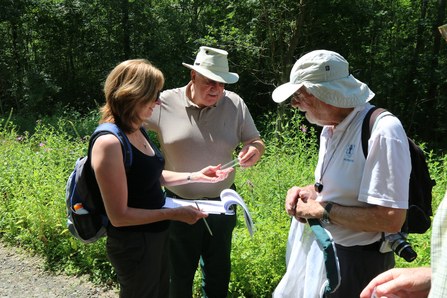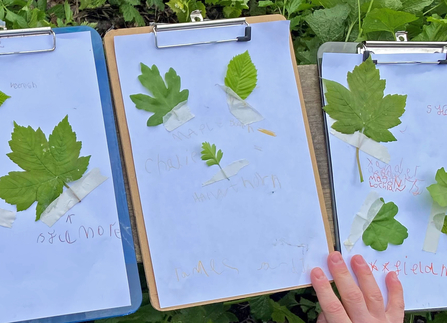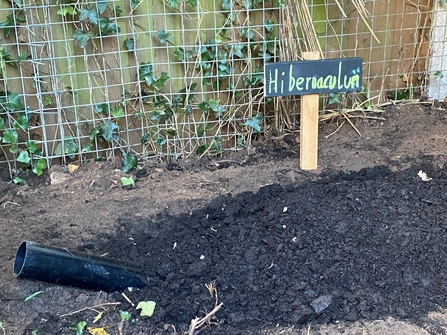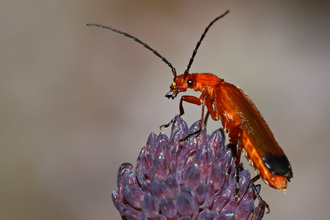It's the bioblitz blog but what actually is a bioblitz? Well, if I say I am going to ‘blitz the house’ it means everyone is in trouble because it’s too messy and I am going to move things about and tidy up (then it will take weeks to find everything again...from their 'safe and obvious' storage spaces).
The bioblitz blog
Aspen leaf-rolling weevil by Richard Clifford

Surveying and identifying wildlife by Wendy Carter
Thankfully, a bioblitz is not a similar tidying of a biological habitat but is an intense period of biological surveying in an attempt to record everything living within a designated area. It takes place over a day or night (sometimes over a few days) in order to record as many species as possible. Essentially, it's about blitzing an area to get as many biological (wildlife) records as possible. But it's also about encouraging people to meet naturalists or working scientists and ask them questions to learn more about the amazing creatures that we share this planet with.
When you're working in natural spaces, such as the nature reserve at Monkwood, it's really important that any decisions about management are made based on a sound scientific basis, which includes knowledge of what's there. Not only does mean the species that are there now, like the gorgeous aspen leaf-rolling weevil in the photo at the top of the blog, but it's really useful to understand the history of the area and the species that might once have been present. At Monkwood we are incredibly lucky to have the working management plans from the LG Harris & Co. Ltd brush company that owned the woodland before the Trust bought it in the 1980s. This tells us which trees were taken out and which new ones were put in. It explains how they coppiced certain parts and clear felled others. This is valuable information for Dominque, the reserves officer, as trees really influence what else grows and lives in a woodland. Even more than this, however, is the fantastic Wichenford Historical Society that has been researching Monkwood to give us a wealth of information about how it was used in the past for wood pasture, grazing and coppicing.

Leaf identification by Hallow Primary School children
The acquiring of land at neighbouring Green Farm has provided the Trust with a new area of land to survey and manage. This is mirrored in the work I've been doing in schools where we look at what wildlife is in the school grounds - trees, hedges, flowers, minibeasts - before we review what we could do to improve the grounds for wildlife.

Hibernaculum in Broadheath Primary School by Julie Grainger
In one local school the eco-club surveyed trees, minibeasts and the pond. There was great excitement in finding a newt and so the eco-club decided to put in a hibernaculum - a home for newts, toads and frogs. Then, because we didn’t find many beetles or woodlice, the children created some beetle buckets too. Next, I think, will be a wildflower meadow to increase numbers of pollinators. This process of surveying and then improving is relevant to schools, gardens and to our nature reserves; we can all use this way of working to take action for wildlife.
With that in mind, we are soon holding a Discover Monkwood bioblitz to discover what is in the wooded areas and the new Green Farm land. This will take place in two ways; firstly the Worcestershire Recorders will be at Monkwood looking for species they specialise in, then there will be a less formal event where we are asking members of the community to come and help contribute and learn about different species of plants and animals. The good news is that you and I don't need to be experts at identifying wildlife because there'll be people from the Trust and from the Worcestershire Recorders to show us how to look for and identify the wildlife around us. Any records on the day will contribute to the bioblitz data and will be submitted to the county database.
So if you would like to know what the yellow butterfly is that you've seen recently at Monkwood or which bird you are hearing from the top of a tree that somehow you can never see, then this is great opportunity to find out and learn more. Or if you would like to be more creative or artistic on the day then please come along with your sketchbook in hand. Please join us on 31st May - we'll be looking at everything from moths and butterflies in the morning to bats in the evening. However, I do have one warning - you might want to bring wellies because, if we don't get some sunshine soon, Monkwood mud might remain as squelchy as it is now!





